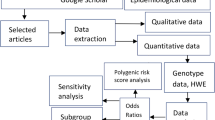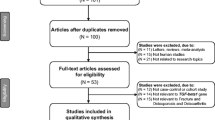Abstract
A functional polymorphism in methylenetetrahydrofolate reductase (MTHFR) has been identified at codon 677 (C677T). The T-allele variant (valine type) has lower enzyme activity than the wild type (C-allele or alanine type), resulting in a slightly elevated homocysteine level, which has been recently recognized as a risk factor for fracture. However, whether subjects bearing the T allele have higher susceptibility to fractures is still controversial. We have investigated the effects of MTHFR polymorphism on fracture susceptibility in Japanese postmenopausal women. A total of 502 postmenopausal ambulatory Japanese women were followed up for 5.1 ± 3.4 (mean ± SD) years, and a total of 155 patients with incident fractures (121 patients with vertebral fractures and 34 cases with fractures at other sites) were recorded. When compared with the patients without any fractures, the patients with incident fractures were older, had more prevalent fractures, had higher urinary levels of bone turnover markers as well as plasma homocysteine level, but were shorter in body height and had lower bone mineral density. The prevalence of the TT genotype of MTHFR was significantly higher in the patients with incident fractures compared to the other genotypes. The subjects with the TT genotype had a higher incidence rate of fracture and higher plasma level of homocysteine than the subjects bearing the non-TT genotype. This relationship was observed in both osteoporotic and nonosteoporotic groups. The hazard ratio for TT genotype without osteoporosis, non-TT genotype with osteoporosis, and TT genotype with osteoporosis was 1.49 (0.91–2.45), 3.64 (2.50–5.29), and 7.21 (4.34–11.97), respectively, compared to the non-TT genotype without osteoporosis. A higher hazard ratio for the TT genotype with osteoporosis was still apparent after adjustment for age, body size, and number of prevalent vertebral fractures. These results indicate that the TT genotype of MTHFR may be a risk factor for future fracture in addition to the traditional risk factors.
Similar content being viewed by others
References
NIH Consensus Development Panel on Osteoporosis Prevention, Diagnosis, and Therapy (2001) Osteoporosis prevention, diagnosis, and therapy. JAMA 285:785–795
Silverman SL, Minshall ME, Shen W, Harper KD, Xie S (2001) Health-Related Quality of Life Subgroup of the Multiple Outcomes of Raloxifene Evaluation Study. The relationship of healthrelated quality of life to prevalent and incident vertebral fractures in postmenopausal women with osteoporosis: results from Multiple Outcomes of Raloxifene Evaluation Study. Arthritis Rheum 44:2611–2619
Oleksik A, Lips P, Dawson A, Minshall ME, Shen W, Cooper C, Kanis J (2000) Health-related quality of life in postmenopausal women with low BMD with or without prevalent vertebral fractures. J Bone Miner Res 15:1384–1392
Kanis JA, McCloskey EV (1992) Epidemiology of vertebral osteoporosis. Bone (NY) 13(suppl 2):S1–S10
Center JR, Nguyen TV, Schneider D, Sambrook PN, Eisman JA (1999) Mortality after all major types of osteoporotic fracture in men and women: an observational study. Lancet 353:878–882
Kado DM, Browner WS, Palermo L, Nevitt MC, Genant HK, Cummings SR (1999) Vertebral fractures and mortality in older women: a prospective study. Study of Osteoporotic Fractures Research Group. Arch Intern Med 159:1215–1220
Kanis JA, Black D, Cooper C, Dargent P, Dawson-Hughes B, De Laet C, Delmas P, Eisman J, Johnell O, Jonsson B, Melton L, Oden A, Papapoulos S, Pols H, Rizzoli R, Silman A, Tenenhouse A (2002) International Osteoporosis Foundation; National Osteoporosis Foundation. A new approach to the development of assessment guidelines for osteoporosis. Osteoporos Int 13:527–536
Orimo H, Hayashi Y, Fukunaga M, Sone T, Fujiwara S, Shiraki M, Kushida K, Miyamoto S, Soen S, Nishimura J, Oh-hashi Y, Hosoi T, Gorai I, Tanaka H, Igai T, Kishimoto H (2001) Osteoporosis Diagnostic Criteria Review Committee: Japanese Society for Bone and Mineral Research. Diagnostic criteria for primary osteoporosis: year 2000 revision. J Bone Miner Metab 19:331–337
Garnero P, Hausherr E, Chapuy MC, Marcelli C, Grandjean H, Muller C, Cormier C, Breart G, Meunier PJ, Delmas PD (1996) Markers of bone resorption predict hip fracture in elderly women: the EPIDOS Prospective Study. J Bone Miner Res 11:1531–1538
van Daele PL, Seibel MJ, Burger H, Hofman A, Grobbee DE, van Leeuwen JP, Brikenhager JC, Pols HA (1996) Case-control analysis of bone resorption markers, disability, and hip fracture risk: the Rotterdam study. Br Med J 312:482–483
Garnero P, Sornay-Rendu E, Claustrat B, Delmas PD (2000) Biochemical markers of bone turnover, endogenous hormones and the risk of fractures in postmenopausal women: the OFELY study. J Bone Miner Res 15:1526–1536
Shiraki M, Kuroda T, Nakamura T, Fukunaga M, Hosoi T, Orimo H, Makino K (2006) The sample size required for intervention studies on fracture prevention can be decreased by using a bone resorption marker in the inclusion criteria: prospective study of a subset of the Nagano Cohort, on behalf of the Adequate Treatment of Osteoporosis (A-TOP) Research Group. J Bone Miner Metab 24:219–225
Devoto M, Speccia C, Li HH, Caminis J, Tenenhouse A, Rodriguez H, Spotila LD (2001) Variance component linkage analysis indicates a QTL for femoral neck bone mineral density on chromosome 1p36. Hum Mol Genet 10:2447–2452
Gjesdal CG, Vollset SE, Ueland PM, Refsum H, Meyer HE, Tell GS (2007) Plasma homocysteine, folate, and vitamin B12 and the risk of hip fracture. J Bone Miner Res 22:747–756
van Meurs JB, Dhonukshe-Rutten RA, Pluijim SM, van der Klift M, de Jonge R, Lindemans J, de Groot LC, Hofman A, Witteman JC, van Leeuwen JP, Breteler MM, Lips P, Pols HA, Uitterlinden AG (2004) Homocysteine levels and the risk of osteoporotic fracture. N Engl J Med 350:2033–2041
McLean RR, Jacques PF, Selhub J, Tucker KL, Samelson EJ, Broe KE, Hannan MT, Cupples LA, Kiel DP (2004) Homocysteine as a predictive factor for hip fracture in older persons. N Engl J Med 350:2042–2049
Lubec B, Fang-Kircher S, Lubec T, Blom HJ, Boers GH (1996) Evidence for McKusick’s hypothesis of deficient collagen crosslinking in patients with homocystinuria. Biochim Biophys Acta 1315:159–162
Khan M, Yamauchi M, Srisawasdi S, Stiner D, Doty S, Paschalis EP, Boskey AL (2001) Homocysteine decreases chondrocytemediated matrix mineralization in differentiating chick limb-bud mesenchymal cell micro-mass cultures. Bone (NY) 28:387–398
Miyao M, Morita H, Hosoi T, Kurihara H, Inoue S, Hoshino S, Shiraki M, Yazaki Y, Ouchi Y (2000) Association of methylenetetrahydrofolate reductase (MTHFR) polymorphism with bone mineral density in postmenopausal Japanese women. Calcif Tissue Int 66:190–194
McDonald HM, McGuian FE, Fraser WD, New AS, Ralston SH, Reid DM (2004) Methylenetetrahydrofolate reductase polymorphism interacts with riboflavin intake to influence bone mineral density. Bone (NY) 35:957–964
Li M, Lau EMC, Woo J (2004) Methylenetetrahydrofolate reductase polymorphism (MTHFRC677T) and bone mineral density in Chinese men and women. Bone (NY) 35:1369–1374
Abrahamsen B, Madsen JS, Tofteng CL, Stilgren L, Bladbjerg EM, Kristensen SR, Brixen K, Mosekilde L (2005) Are effects of MTHFR (C677T) genotype on BMD confined to women with low folate and riboflavin intake? Analysis of food records from the Danish osteoporosis prevention study. Bone (NY) 36:577–583
Abrahamsen B, Jogensen HL, Nielsen TL, Andersen M, Haug E, Schwarz P, Hagen C, Brixen K (2006) MTHFR c.677C > T polymorphism as an independent predictor of peak bone mass in Danish men: results from the Odense Androgen Study. Bone (NY) 38:215–219
Jogensen HL, Madsen JS, Madsen B, Saleh MMA, Abrahamsen B, Fenger M, Lauritzen JB (2002) Association of a common allelic polymorphism (C677T) in the methylenetetrahydrofolate reductase gene with a reduced risk of osteoporotic fractures. A case control study in Danish postmenopausal women. Calcif Tissue Int 71:386–392
Abrahamsen B, Madsen JS, Tofteng CL, Stilgren L, Bladbjerg EM, Kristensen SR, Brixen K, Mosekilde L (2003) A common methylenetetrahydrofolate reductase (C677T) polymorphism is associated with low bone mineral density and increased fracture incidence after menopause: longitudinal data from the Danish osteoporosis prevention study. J Bone Miner Res 18:723–729
Villadsen MM, Bunger MH, Carstens M, Stenkjar L, Langdahl BL (2005) Methylenetetrahydrofolate reductase (MTHFR) C677T polymorphism is associated with osteoporotic vertebral fractures, but is a weak predictor of BMD. Osteoporosis Int 16:411–416
Hong X, Hsu Y-H, Terwedow H, Tang G, Liu X, Jiang S, Xu X, Xu X (2007) Association of the methylenetetrahydrofolate reductase C677T polymorphism and fracture risk in Chinese postmenopausal women. Bone (NY) 40:727–742
Shiraki M, Shiraki Y, Aoki C, Hosoi T, Inoue S, Kaneki M, Ouchi Y (1997) Association of bone mineral density with apolipoprotein E phenotype. J Bone Miner Res 12:1438–1445
Genant HK, Jergas M, Palermo L, Nevitt M, Valentin RS, Black D, Cummings SR (1996) Comparison of semiquantitative visual and quantitative morphometric assessment of prevalent and incident vertebral fractures in osteoporosis. The study of Osteoporotic Fractures Research Group. J Bone Miner Res 11:984–996
Fukunaga M, Nakamura T, Shiraki M, Kuroda T, Ohta H, Hosoi T, Orimo H (2004) Absolute height reduction and percent height ratio of the vertebral body in incident fracture in Japanese women. J Bone Miner Metab 22:104–110
Vester B, Rasmussen K (1991) High performance liquid chromatography method for rapid and accurate determination of homocysteine in plasma and serum. Eur J Clin Chem Clin Biochem 29:549–554
Urano T, Shiraki M, Narusawa K, Usui T, Sasaki N, Hosoi T, Ouchi Y, Nakamura T, Inoue S (2007) Q89R polymorphism in the LDL receptor-related protein 5 gene is associated with spinal osteoarthritis in postmenopausal Japanese women. Spine 32:25–29
Barrett-Connor E, Siris ES, Wehren LE, Miller PD, Abbott TA, Berger ML, Santora AC, Sherwood LM (2005) Osteoporosis and fracture risk in women of different ethnic groups. J Bone Miner Res 20:185–194
Fujiwara S, Kasagi F, Masunari N, Naito K, Suzuki G, Fukunaga M (2003) Fracture prediction from bone mineral density in Japanese men and women. J Bone Miner Res 18:1547–1553
Frosst P, Blom HJ, Milos R, Goyette P, Sheppard CA, Matthews RG, Boers GJ, den Heijer M, Kluijtmans LA, van den Heuvel LP (1995) A candidate genetic risk factor for vascular disease: a common mutation in methylenetetrahydrofolate reductase. Nat Genet 10:111–113
Gueant-Rodriguez RM, Juilliere Y, Candito M, Adjalla CE, Gibelin P, Herbeth B, Van Obberghen E, Gueant JL (2005) Association of MTRRA66G polymorphism (but not of MTHFR C677T and A1298C, MTRA2756G, TCN C776G) with homocysteine and coronary artery disease in the French population. Thromb Haemost 94:510–515
Kluijtmans LA, Young IS, Boreham CA, Murray L, McMaster D, McNulty H, Strain JJ, McPartlin J, Scott JM, Whitehead AS (2003) Genetic and nutritional factors contributing to hyperhomocysteinemia in young adults. Blood 101:2483–2488
de Bree A, Verschuren WM, Bjorke-Monsen AL, van der Put NM, Heil SG, Trijbels FJ, Blom HJ (2003) Effect of the methylenetetrahydrofolate reductase 677C → T mutation on the relations among folate intake and plasma folate and homocysteine concentrations in a general population sample. Am J Clin Nutr 77:687–693
Barbosa PR, Stabler SP, Machado AL, Braga RC, Hirata RD, Hirata MH, Sampaio-Neto LF, Allen RH, Guerra-Shinohara EM (2007) Association between decreased vitamin levels and MTHFR, MTR and MTRR gene polymorphisms as determinants for elevated total homocysteine concentrations in pregnant women. Eur J Clin Nutr. doi:10.1038/sj.ejcn.1602810
Kim DJ, Koh JM, Lee O, Kim NJ, Lee YS, Kim YS, Park JY, Lee KU, Kim GS (2006) Homocysteine enhances apoptosis in human bone marrow stromal cells. Bone (NY) 39:582–590
Raposo B, Rodriguez C, Martinez-Gonzalez J, Badimon L (2004) High levels of homocysteine inhibit lysyl oxidase (LOX) and downregulate LOX expression in vascular endothelial cells. Atherosclerosis 177:1–8
Saito M, Fujii K, Marumo K (2006) Degree of mineralizationrelated collagen crosslinking in the femoral neck cancellous bone in cases of hip fracture and controls. Calcif Tissue Int 79:160–168
Shiraki M, Kuroda T, Tanaka S, Saito M, Fukunaga M, Nakamura T (2008) Nonenzymatic collagen cross-links induced by glycoxidation (pentosidine) predicts vertebral fractures. J Bone Miner Metab 26:93–108
Author information
Authors and Affiliations
Corresponding author
About this article
Cite this article
Shiraki, M., Urano, T., Kuroda, T. et al. The synergistic effect of bone mineral density and methylenetetrahydrofolate reductase (MTHFR) polymorphism (C677T) on fractures. J Bone Miner Metab 26, 595–602 (2008). https://doi.org/10.1007/s00774-008-0878-9
Received:
Accepted:
Published:
Issue Date:
DOI: https://doi.org/10.1007/s00774-008-0878-9




